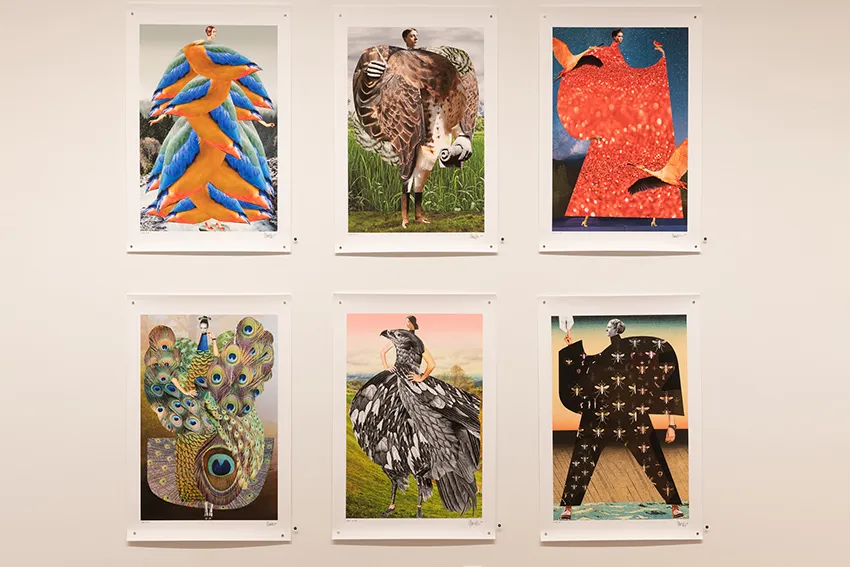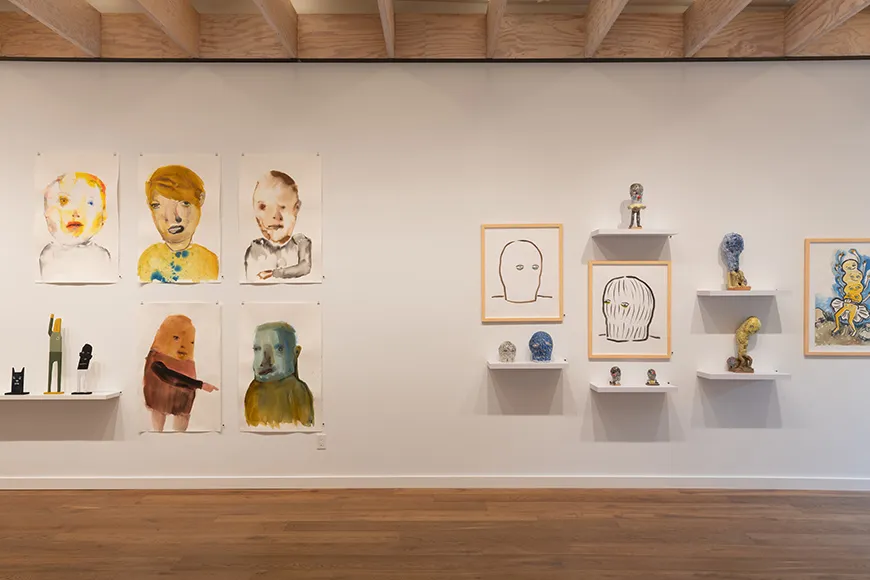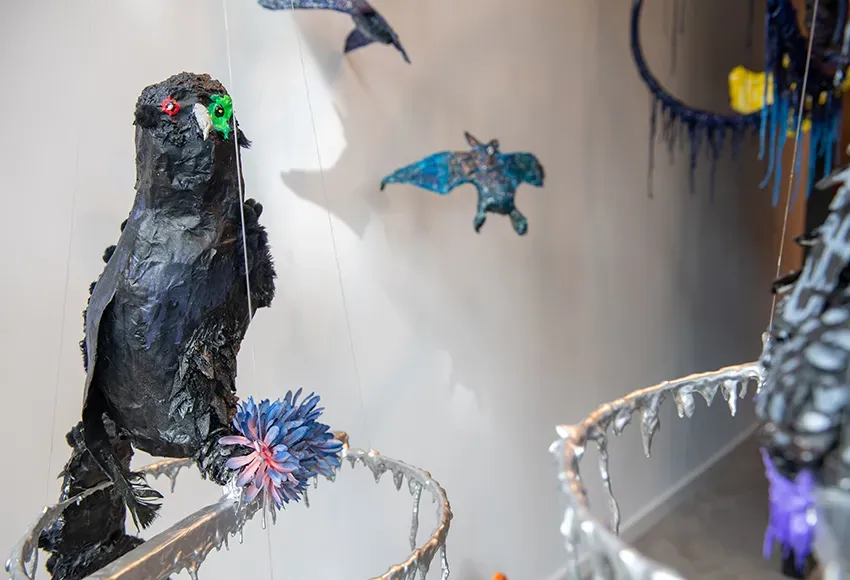AMcE Creative Arts is hosting an exhibition at its gallery in the Miller Park neighborhood. Titled HUMAN/ANIMAL, it brings together the works of ten artists to explore "what it is to be a human animal," with media ranging from papier-mâché to porcelain sculpture.
Kendra Larson brought her work all the way up from Portland, Ore., to feature big in the gallery's front windows, where her animal figures of paper, plaster, wire, and paint – owls, bears, bats, and the like – displayed starry skies on their well-textured pelts and bright outpourings of color on their faces. Larson said she had worked with these media for a long time, but these were the first she had shown off at an event.
The themes of animal symbolism and mysticism continued through the creations of Sarah Gordon, a British artist and textile designer working out of her studio on Bainbridge Island. Her acrylic illustrations on watercolor paper featured animals, plants, and other natural elements in stylish abstraction, with contrasting colors and patterns both natural and off-beat. The titles of the pieces anthropomorphized the animals therein, such as Philosopher, Extroverted Introvert, and Maximalist.
The works of painter Robin McCauley of Rockford, Ill., had titles of a similar kind, emphasizing the unique talents of her subjects. Each of her pieces was a hyperrealistic rendition of a nonhuman animal on a black background, with a single red line running through the frame – some held in a mouth, claw, or beak, and other odd ones tugged to an angle by a forepaw, or freestanding.
Los Angeles painter Matt Adrian displayed a collection of realistic bird portraits, rendered in acrylic with stunning detail, with titles like I Assure You That My Knives and Swords Are Strictly Ceremonial. One of his books, The Mincing Mockingbird Guide to Troubled Birds, was available for sale at the front.
The most direct depictions of nonhuman animals ended there, then the boundaries began to blur even further. Debra Broz of Los Angeles has been using the rare skill of ceramics restoration to seamlessly combine pieces of old porcelain figurines into chimeras of kitsch, such as a dolphin with a cartoon boy's head, or Victorian noblewomen with pink elephant features. Broz said the oddities might draw attention to the medium, which she felt was often ignored.

New York illustrator Johanna Goodman's digital collages, all from her massive collection titled Catalogue of Imaginary Beings, brought to life titanic characters composed of disparate parts: towering figures made from birds, supermodels, old black-and-white portraits, and seas of glitter, all with an impressive clarity to their poses despite their bulky attire.

LA ceramicist Kim Tucker's sculptures and watercolors made up a few more ambiguous human-animal figures, which were often armless but standing upright, with bulbous heads, round noses, tired eyes, and painted fur. The more minimalist portraits of hers were a recent development, Tucker said, and she described her work as having a "lineage," with each piece evolving from the last.
Yet another LA artist, Jon Huck, brought more of his popular watercolor portraits and painted wooden sculptures. His portraits were abstract, with colors bleeding into each other yet respecting the boundaries of grander shapes, and though his faces possessed a vagueness, like a dream half-remembered, they carried a great deal of personality.
The most direct depictions of humans came from Kim Bagwill and Kirsten Tradowsky, both of whom worked in oil paint on panels. Bagwill's paintings were unique in composition, with human faces on bold, solid colors, cut short by the edges of the panels. Some of the partial faces stare straight out at the viewer, and others look elsewhere, but all give a strange feeling of candidness.
Finally, Tradowsky's paintings were copied from found photos of birthday celebrations, block parties, and other gatherings of yore, mimicking the photos down to their color palettes but with far less clarity of detail.
As a whole, the exhibition explored the theme of human animals with a net cast wide, bringing together playful works in what AMcE curator McLean Emenegger had hoped would be "a visual cocktail party." It's fitting, then, that the energy on the opening evening was electric. Emenegger said she was thrilled that there were far more visitors than she expected.
The HUMAN/ANIMAL group exhibition will be on display at AMcE Creative Arts (612 19th Ave. E.) until June 11, 2022. Until then, the works displayed in the gallery and in the store at the front are for sale.
You can preview the gallery and find out more at https://amcecreativearts.com/.


